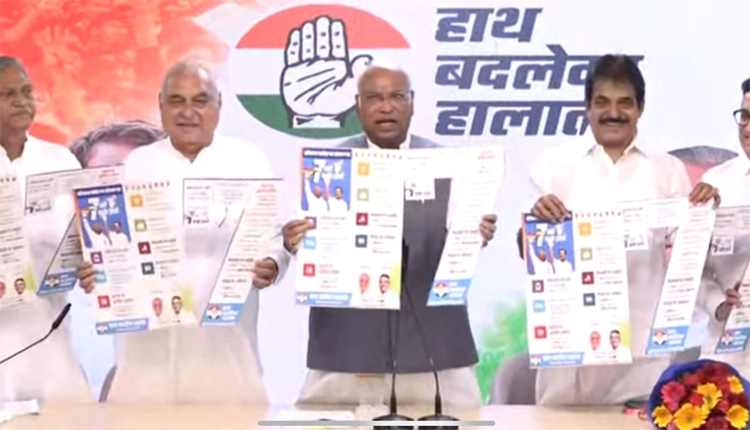Chandigarh: As the Haryana elections loom, the Congress party unveiled its detailed manifesto today in Chandigarh, aiming to address key voter concerns with a range of welfare schemes. However, the event was overshadowed by the notable absence of prominent leaders Randeep Surjewala and Kumari Selja, raising questions within the party and among political observers.
The Congress manifesto launch, held on 28 September, was intended to solidify the party’s stance ahead of the elections. Despite the strategic significance, the absence of influential leaders Randeep Surjewala and Kumari Selja was conspicuous. Both leaders have been vocal about internal disagreements, particularly regarding ticket distribution and contentious remarks, which have fueled speculation about factionalism within the party.
In stark contrast, senior figures such as Congress state president Uday Bhan, former Chief Minister Ashok Gehlot, and former Chief Minister Bhupinder Singh Hooda were present, leading the charge in the manifesto presentation. Their participation underscored the party’s reliance on established leaders to navigate the current electoral challenges.
Just two days prior, on 26 September, Rahul Gandhi addressed a rally in Haryana alongside Kumari Selja and former Chief Minister Bhupinder Singh Hooda, delivering a unified message of mutual solidarity. This recent display of unity stood in sharp contrast to the fragmented atmosphere observed at today’s manifesto launch, where the absence of key leaders suggested underlying tensions.
The Congress manifesto for Haryana encompasses an extensive array of policies designed to appeal to a broad voter base. Key proposals include:
- Healthcare: Introduction of a health guarantee scheme modeled after Rajasthan’s, offering free treatment up to ₹25 lakh.
- Education: Addressing issues related to the NEET exam to streamline medical education.
- Women’s Welfare: Launch of the Indira Ladli Behan Samman Yojana, providing ₹2,000 monthly to women aged 18-60.
- Farmers’ Rights: Formation of a Farmers Commission, guaranteeing Minimum Support Price (MSP) for crops, and providing special facilities for women farmers, including diesel subsidy cards.
- Infrastructure Development: Construction of a university in Kurukshetra district named after Guru Gobind Singh, development of eco-friendly environments, and improvement of the transport system with electric and CNG buses.
- Minority and Disability Rights: Establishment of boards for Punjabi language and Sikh community welfare, a separate board for disabled individuals, and enhanced rights for rural development and panchayati raj.
- Employment and Pensions: Restoration of old pensions for government employees, job guarantees, and the creation of a Brahmin Commission board.
- Urban Development: Development of metro and railway lines, construction of chhat ghats for Purvanchal residents, and formation of a commission for traders.
- Sports and Paramilitary Support: Full respect for sports, job guarantees, and the establishment of a paramilitary board.
The fragmented attendance at the manifesto launch highlights potential vulnerabilities within the Congress party as it prepares for the upcoming elections. The absence of Randeep Surjewala and Kumari Selja may indicate deeper strategic disagreements or factional divides, potentially weakening the party’s unified front.
Party insiders suggest that addressing these internal issues is crucial for maintaining momentum in the election campaign. The Congress leadership is expected to engage in further discussions to reconcile differences and present a cohesive strategy to voters.
With the Haryana elections approaching, the Congress party faces the dual challenge of presenting a compelling manifesto while managing internal dissent. The success of today’s manifesto launch will depend on the party’s ability to unify its leadership and effectively communicate its policies to the electorate.



Comments are closed.